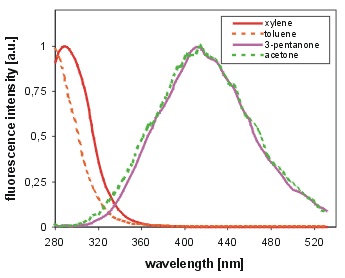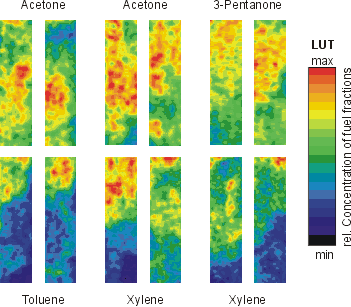Laser diagnostics in Combustion: Simultaneous Imaging of multiple Volatility Classes
Fuel distributions prior to ignition in internal combustion engines significantly influence the combustion process. This is of special interest when inhomogeneous loads are considered, as in modern ultra-lean burning engines using stratified load configurations or when gas recirculation is employed. When using multicomponent fuels as is the case with commercially available gasoline, components with different volatility are expected to display different distributions within the combustion chamber. This separation of fuel components connected with the overall fuel distribution was addressed using laser induced fluorescence measurements for acquiring quantitative two-dimensional fuel concentration distributions, which in turn can be used for evaluating numerical simulations of the ignition and the combustion process.

Figure 1: LIF emission spectra of different ketonic and aromatic tracers.
A Raman-shifted excimer laser was used to produce ultra-short light pulses at 276 nm for the excitation of tracers for fuel components of different volatility classes. The properties of the resulting fluorescence of potential tracers were investigated using a heated static high-pressure cell in respect of emission behaviour, temperature and pressure dependence, and quenching influences. Fluorescence occurs in distinctly different spectral regions for ketones and benzene derivatives which were finally chosen as tracer species. Thus, a suitable pair of a ketone and an aromatic species can be employed to simultaneously monitor distributions of fuel components of different volatility. Several such tracer pairs were used to evaluate time-resolved 2D fuel distributions in an optically accessible port-injected engine run on a three-component non-fluorescing fuel, with each of the fuel fractions representing a different volatility class.

Figure 2: Distribution of different fuel volatility classes imaged using different tracer pairs. Images within a column are taken simultaneously showing the inhomogeneous distribution of different species during the mixing process (measurement at 100dca).
References:
[1] H. Krämer, S. Einecke, C. Schulz, V. Sick, S. R. Nattrass, J. S. Kitching, Simultaneous mapping of the distribution of different fuel volatility classes using tracer LIF and NIR tomography in an IC engine, SAE Fall Fuels&Lubricants Meeting, 1998, paper No. 982467, 1998 SAE Transactions, Vol. 107, Journal of Fuels & Lubricants, pp. 1048-1059.
[2] F. Großmann, P. B. Monkhouse, M. Ridder, V. Sick, J. Wolfrum, Temperature and pressure dependences of the fluorescence of gas-phase acetone and 3-pentanone, Appl. Phys. B 62, 249-253 (1996).
Weitere Literatur zum Einsatz von Tracern in der abbildenden Kraftstoffdiagnostik:
[3] C. Taut, C. Correa, O. Deutschmann, J. Warnatz, S. Einecke, C. Schulz, and J. Wolfrum, "3D-modeling with Monte-Carlo-PDF methods and laser diagnostics of the combustion in a two-stroke engine," Proc. Combust. Inst. 28, 1153-1159 (2000).
[4] J. Kazenwadel, W. Koban, T. Kunzelmann, and C. Schulz, "Fluorescence imaging of natural gas / air mixing without tracers added," Chem. Phys. Lett. 345, 259-264 (2001).
[5] N. Graf, J. Gronki, C. Schulz, T. Baritaud, J. Cherel, P. Duret, and J. Lavy, "In-cylinder combustion visualization in an auto-igniting gasoline engine using fuel tracer- and formaldehyde-LIF imaging," SAE Technical Paper Series 2001-01-1924 (2001).
[6] T. Fuyuto, H. Kronemayer, B. Lewerich, W. Koban, K. Akihama, and C. Schulz, "Laser-based temperature imaging close to surfaces with toluene and NO-LIF," in International Conference on Laser Diagnostics, ICOLAD2005 (London, 2005), 53-61.
[7] S. Einecke, C. Schulz, and V. Sick, "Measurement of temperature, fuel concentration and equivalence ratio fields using tracer LIF in IC engine combustion," Appl. Phys. B 71, 717-723 (2000).
[8] M. Luong, W. Koban, and C. Schulz, "Novel strategies for imaging temperature distribution using toluene LIF," in International Conference on Laser Diagnostics, ICOLAD2005 (London, 2005), 155-161.
[9] W. Koban, J. Schorr, and C. Schulz, "Oxygen distribution imaging with a novel two-tracer laser-induced fluorescence technique," Appl. Phys. B 74, 111-114 (2002).
[10] W. Koban, J. D. Koch, V. Sick, N. Wermuth, R. K. Hanson, and C. Schulz, "Predicting LIF signal strength for toluene and 3-pentanone under engine-related temperature and pressure conditions," Proc. Combust. Inst. 30, 1545-1553 (2005).
[11] D. Frieden, V. Sick, J. Gronki, and C. Schulz, "Quantitative oxygen imaging in an engine," Appl. Phys. B 75, 137-141 (2002).
[12] W. Koban and C. Schulz, "Toluene as a tracer for fuel, temperature and oxygen concentrations," SAE technical paper series 2005-01-2091 (2005).
[13] C. Schulz and V. Sick, "Tracer-LIF diagnostics: Quantitative measurement of fuel concentration, temperature and air/fuel ratio in practical combustion situations," Prog. Energy Combust. Sci. 31, 75-121 (2005).
[14] S. Einecke, C. Schulz, V. Sick, A. Dreizler, R. Schießl, and U. Maas, "Two-dimensional temperature measurements in an SI engine using two-line tracer LIF," SAE Technical Paper Series 982468 (1998).
Weitere Literatur zu spektralen Eigenschaften von Tracersubstanzen:
[15] W. Koban, J. D. Koch, R. K. Hanson, and C. Schulz, "Toluene LIF at elevated temperatures: Implications for fuel/air ratio measurements," Appl. Phys. B 80, 147-150 (2005).
[16] J. D. Koch, W. Koban, C. Schulz, and R. K. Hanson, "Rayleigh-calibrated fluorescence quantum yield measurements of acetone and 3-pentanone," Applied Optics 43, 5901-5910 (2004).
[17] W. Koban, J. D. Koch, R. K. Hanson, and C. Schulz, "Oxygen quenching of toluene fluorescence at elevated temperatures," Appl. Phys. B 80, 777-784 (2005).
[18] W. Koban, J. D. Koch, R. K. Hanson, and C. Schulz, "Absorption and fluorescence of toluene vapor at elevated temperatures," Phys. Chem. Chem. Phys. 6, 2940-2945 (2004).
[19] F. Zimmermann, W. Koban, C. M. Roth, D.-P. Herten, and C. Schulz, "Fluorescence lifetime of gas-phase toluene at elevated temperatures," Chem. Phys. Lett., in press (2006).
